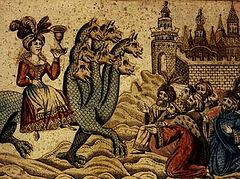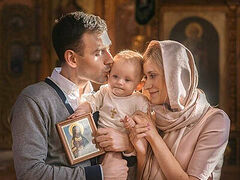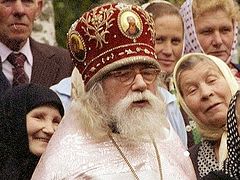A year ago it was announced that a collection was underway of testimonies about help from Elder-Archimandrite John (Krestiankin). Since then, received hundreds of such stories have been submitted, many of which simply amazed us by their artless truth. And on the eve of Fr. John’s repose day, the website Pravoslavie.ru began its publication of the most interesting testimonies. On the repose day of Fr. John (Krestiankin), we are publishing the first of these testimonies in English.
 Archimandrite John (Krestiankin)
Archimandrite John (Krestiankin)
I have always been wary of such things as testimonies. I can’t prove it, but I sincerely believe that through the prayers of Fr. John (Krestiankin) a miracle happened in our family: the complete recovery of a child’s health.
My granddaughter Maria (she’s now fourteen years old, and in April she’ll be fifteen) was born with a handicap of her psychological development. She was diagnosed with this at age three. She was transferred from an ordinary nursery school to a corrective school. The commission of child handicap specialists and speech therapists in the older group of the nursery school said when the girl was six years old that we should prepare ourselves for the reality that she will not be accepted into first grade at the elementary school, and may God grant that she at least be able to take care of herself. They assured us that she may not even be accepted into a corrective school, because by age seven the girl could only pronounce a few words, and was practically unable to put them into a sentence. We didn’t even discuss reading or counting.
Not long before Maria’s seventh birthday we were given the book by Fr. Tikhon (Shevkunov), Everyday Saints. I read it over and over again; the description of the elders impressed me as absolutely alive, very close to me, like family. Back in 1997 I had taken anthropology students studying cultural architecture to the Pskov Caves Monastery. We attended evening service, requested prayers at the perpetual Psalter reading, and fell unaccountably in love with the place—although we were very far from Orthodoxy at the time. But I think that we personally saw all the elders at the evening service, where they prayed for us “worshippers at this holy temple”.
My husband also liked the book, Everyday Saints. He read it many times, purchased many copies and constantly gave them to his friends as a gift. Finally, along with one such book a CD came into our hands with the film about the Pskov Caves Monastery. We watched it at home many times, and even made a copy for our phones of Fr. John’s sermon about how we must love our enemies, so that we could simply listen to Fr. John’s voice.
At one point the quantity of watching time apparently turned into quality—I had an uncanny desire to go to the Pskov Caves Monastery. My longing was unaccountable, but somehow very strong. We bought train tickets for two adults and two children: my granddaughter Maria had just turned seven at the end of April. And we decided that since we were going, Maria’s first confession would take place in the Pskov Caves Monastery.
A couple of days before we left, my work happened to take me right next to Sretensky Monastery in Moscow, and so I decided to go there and ask a blessing for my trip from the first priest I saw. I entered the gates, walked along the pathway, and a priest appeared right there before me. I ran over to him and hastily told him I was going to Pechory, and stretched my hands forth for a blessing. He melted into a smile, blessed me, and disappeared into the church doorway. A crowd of matushkas lunged after him like the roar of an airplane. I asked one of them who he was and she answered, “Tikhon Shevkunov”. What’s most surprising is that I didn’t recognize him, even after seeing him so many times in the film.
Further on some real miracles began. We arrived at the monastery on a randomly picked day, without guessing at anything. The sun was bright, and the voice of Fr. John (Krestiankin) sounded out across the monastery yard—they were playing recordings of his sermons. Naturally we immediately recognized his voice and understood that we had “accidentally” come to the monastery on a day of his commemoration, on a feast day that was connected with him. We went to the church for services, but when seven-year-old Maria walked up to the priest for the first confession of her life and the priest asked her, “Well, what sins do you have?” Maria, despite all our explanatory discussions could not say a word. The priest then called me over and said, “I can’t confess her like that, you should have talked with the child and explained it all to her beforehand.” I was so confused that I couldn’t get it out coherently that the child is emotionally underdeveloped, and she’ll hardly be able to have confession in the normal way.
 The God-given caves of the Pskov Caves Monastery. Photo: Viktor Kornushin.
The God-given caves of the Pskov Caves Monastery. Photo: Viktor Kornushin.
We went out upset and ambled around the courtyard to the caves. We very badly want to go to the grave of Fr. John. But they weren’t letting anyone into the caves, because a service was about to start there. We stood downtrodden by the cordon when suddenly we saw a batiushka walking up to it, whom we’d seen as a young monk in the film. My husband nudged me in the side and said, “Look”. I ran over to that priest, calling him by his name. He asked how I knew him. I told him that all of the people in that film were like family to us. He inquired why we’d come. I told him about Maria, who was standing not far away. Batiushka gathered up several children who were standing near the caves, several of their parents, and led us into the caves with the words, “Well, since you already know everything, I won’t tell you about each monk. I’ll just show you who lies where.” When we came to the place where Archimandrite John (Krestiankin) rests, the monk invited each of us to put our hands through the opening, and after praying, touch Fr. John’s coffin. But seven-year-old Maria (she was short for her age) simply took off running and pushed her way through the opening in the wall where the coffins lay. “Did you reach it?” the monk asked. “I reached it,” the child shouted from the other side, very joyfully. To be honest, I felt rather uneasy…
We left the caves to beyond the cordon. And little Maria stood up and stand, “I want to go back.” She was unmovable and wouldn’t leave. “My child,” I answered, “we’ve been incredibly lucky as it is. Don’t you see, they’re not letting anyone in, but we’ve already been there.” But she wouldn’t leave, and insisted on having her own way. Meanwhile the service in the caves began and ended. And then at the cave entrance a small group of pilgrims suddenly appeared. They were hurriedly let in, and the priest on watch at the entrance said to me, “Well, why are you just standing there—go in after them!” This despite the fact that a huge crowd of people wanting to get in were standing by the entrance. They all waited patiently.
That is how Maria and I ended up in the caves that day for the second time. They anointed her with holy oil from the lampada hanging before Fr. John’s coffin after the service that had just taken place.
The next day we again went to the monastery for the morning service. This time a different priest called Maria over for confession and talked with her for a half an hour. I went up to him after her confession, told him about our sorrow, and he said, word for word: “Look into her eyes. They’re intelligent. No, this is no development problem, it’s something else. Take her to confession and Communion more often.” That is how the girl received Communion for the first time in her life on that day, after her own confession. It means that she was able to tell him something.
We returned to Moscow. Then everything began to come together in a miraculous way. Maria was unexpectedly accepted into the corrective school, and moreover during the commission there happened to be an experienced child handicap specialist who noticed that the girl had silently read with her eyes the entire text given her, although she didn’t pronounce a single word aloud. Maria was accepted into the first (correctional) grade. And then the situation began to improve by seven-mile steps; the child somehow quickly began to talk, read, and count. She blended in with the rest of the class, without any issues.
By the fifth grade, it was decided to combine this correctional school with the lyceum. We parents and relatives of the handicapped (“special” as they called them) children were very nervous—after all, the lyceum program was more complex even than that of an ordinary school, and the children of the correctional classes were now, according to the new education reforms, supposed take the exams like everyone else. All these years we prayed together by agreement with her godmother every day, and my husband tried to take her several times a month to confession and Communion. We also continually ordered for her (and for us) forty-day Liturgies at the Pskov Caves Monastery. We did this all year. In the end Maria was completely cured and became one of the best students in her class.
And then, just before the seventh grade, Maria herself decided to go and take an extremely difficult exam to enter a specialized chemistry and biology class at her lyceum. Chemistry and biology are now being studied in the eighth grade according to a very difficult university level program. The girl is doing well in school. The most amazing thing is that she’s best at literature (she reads voraciously) and “higher mathematics”. Her head works perfectly well.
Maria doesn’t remember her trip at age seven to the monastery at all. But just the other day I was reading aloud to her the sayings of Fr. John (Krestiankin) from the book of his letters, and she suddenly said, “Grandma, let’s go to the caves, to Fr. John”…




